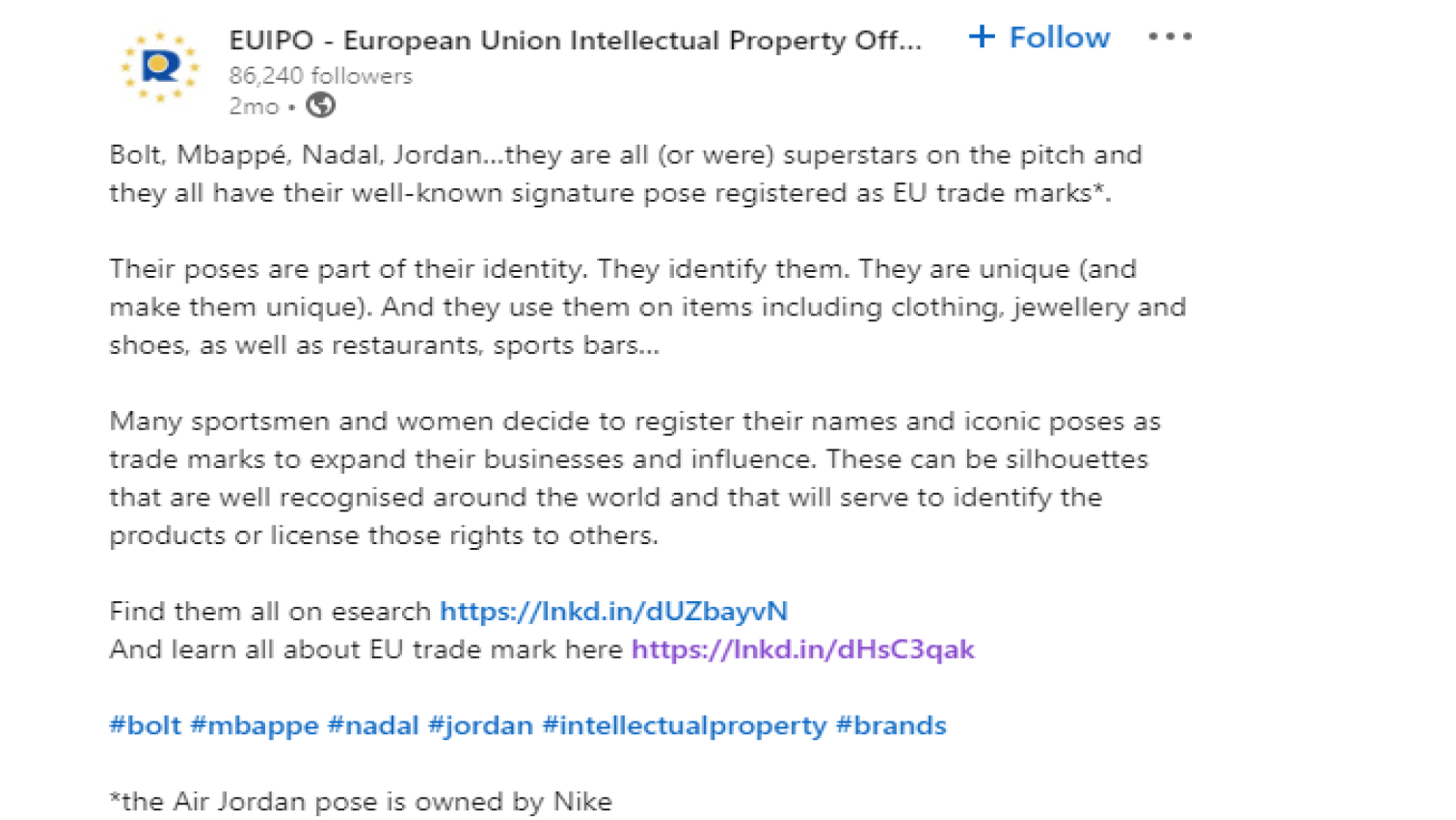When thinking of the word “trademark”, many associate it primarily with logos and brand names. However, it is clear from the European Union Intellectual Property Office’s recent post that celebrities, primarily athletes, take their brand protection a step further.
Most of us probably recognise the famous “Jumpman” logo, a silhouette of Michael Jordan, promoting the Air Jordan brand owned by Nike. However, many more athletes followed suit and started registering their signature poses as trademarks. These include Mo Farah’s “Mobot” gesture (which originated at the London 2012 Olympics, after Mo Farah won gold in the 10,000m) and Usain Bolt’s signature victory pose (where he leans back with one arm bent and the other pointing towards the sky), which he already owns a trademark for in the UK and recently filed an application to register one in the US. Although his racing career may have come to an end, owning a trademark will allow Usain to expand his brand into fashion and food industry and apply his mark to clothing, jewellery, sporting goods or even food and restaurants.
But what if John Doe in Cardiff decided to use a mirror reflection of Usain’s mark as a logo of his newly open gym? Would this infringe Usain’s trademark?
Trademark infringement
In order for a trademark infringement to occur, the alleged infringer must be using a sign which is identical to or similar to the registered trademark and be using it in relation to goods or services which are identical or similar to those for which the trademark is registered. There must also exist a likelihood of confusion on the part of the public, including a likelihood of parties being associated with each other – this can occur even if the infringing goods are not identical or similar, provided that the infringed mark has an established reputation.
Identical or similar mark
An “average consumer” test is used to assess the similarity between the marks (and the general impression of a mark).
If the infringer in our scenario decided to use a mirror reflection of Usain’s mark, it is very likely that an “average consumer” would find the two marks strikingly similar. This is of course a very simplistic example, however there have been instances where infringers altered our clients’ work and/or a mark in a similar way hoping that it would be enough to avoid action being taken against them.
Mark used in relation to good or services which are identical or similar
Usain’s mark is registered in the following classes:
- 9 (eyewear and accessories)
- 14 (clocks, watches and jewellery)
- 16 (Paper, cardboard and goods made from these materials, such as photographs or magazines)
- 18 (Leather/imitations of leather, bags and other cases)
- 25 (clothing and footwear)
- 28 (games, gymnastic and sporting articles)
None of these classes cover gym or fitness facilities, which are the services provided by the infringer. These are covered by Class 41 and since Usain‘s mark is not registered in that class, on the face of it, the infringer may argue that he is free to use the mark as it is neither identical nor similar to any of the classes used by Usain. It may, however, not be that simple because of the link between gymnasiums and gymnastic articles. An argument may ensue about linked or similar goods.
Confusion and association
Even if your mark is identical or similar to the registered one, there must still exist an element of confusion – the lower the risk of confusion to the public, the lower the chances of bringing a successful trademark infringement claim against the infringer. Ultimately, if no one believes (or is likely to believe) that the two brands are in any way connected or associated with each other, then it is unlikely that your business will suffer as a result of the infringer’s actions.
If Usain Bolt had a little clothing company and used his mark for those purposes, the likelihood of people mistaking his brand for the infringer’s gym (and vice versa) would be incredibly low. However, given Usain’s reputation and recognition around the world, it is highly likely that an average consumer could wrongly assume a connection between the newly opened gym and Mr Bolt. Ultimately, he is an athlete and a prominent figure in sport – it would not be that unusual for him to open his own gym chain.
Conclusion
Although not identical, given the similarities between the infringer’s and Usain’s marks, together with the high level of confusion which would most likely be caused, we would recommend that the infringer thinks twice before investing money in the mark and promoting his business that way.
He would also need advice on the potential for a passing off claim. These types of claims do not require anyone to have a registered trademark, and might be brought in cases like the example discussed.
Big brands are increasingly vigilant and have enough resources to monitor any potential infringements. As we can see from the recent dispute between a small business owner from Northampton and Microsoft (Business owner in trademark dispute with Microsoft – BBC News), it does not matter how big or small your business is – the IP protection should be at the forefront of any business owner’s mind and it is therefore vital to get proper legal advice on your intellectual property protection in order to protect your business and avoid any disputes in the future.




